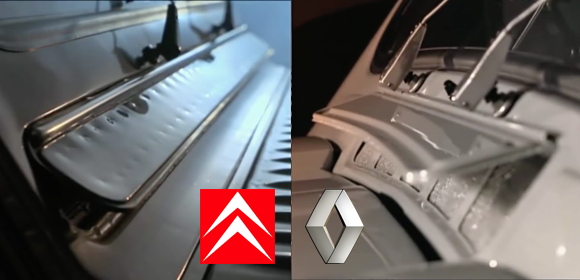by John McCulloch…..
If you have a chance to see the latest film by Thierry Czajko entitled 2CV-4L: “La Guerre des Petites Voitures”, you will find it eminently worthwhile exploration of two iconic French cars. In 52 minutes you will learn the history of the two cars, their development, their targeted consumer and the role that marketing played in the rivalry between the two TPVs (très petites voitures).
The story of the 2CV is well known to subscribers of the CITROËNVIE website. Much has been written about its pre-war conception as a rural workhorse capable of hauling eggs across a ploughed field without any breakage. But also a car in which farmers could carry a pig to market or a family to a pique-nique à la campagne. When the 2CV was ready for production in 1949 few could have predicted that production would last for forty years and turn out 5 million cars.
By the late fifties rival car maker Renault decided to produce a more “modern” car with its older rival but which decidedly had features found in its older rival. These features included front wheel drive, gear lever in the dash board and a shape (in its early stages) which was quite reminiscent of the 2CV. The 4L was aimed at urban consumers, women and younger drivers. The car was an instant hit and as a result 2CV sales slumped 30% in the first year of Renault 4L production. The 4L was made for 30 years resulting in the construction of 8 million cars.
Perhaps the most fascinating part of the film was the marketing campaign waged by Renault. Its ads emphasized the urban nature of the car but also its sporty qualities. Many of the ads showed the 4L in cross country races, on beaches or driving through deep snow. This was in contrast to an almost non-existent advertising campaign on behalf of the 2CV. Citroën no doubt felt that the merits of the 2CV were self evident to its rural based consumer.
But the sixties were marked with the coming of age of the dreaded Baby Boomers. So Citroën decided to aim its advertising at the “fun” generation. Driving with friends, having days at the beach, enjoying picnics in the country became the themes of the print and television ads. It also marked the beginning of new paint jobs for what was by then really dated technology. Everything from the Dolly, Cocorico and finally the Charleston were an attempt to attract a younger urban buyer. My sister always described Charleston drivers as “Gauchistes de bonne famille” – lefties from wealthy homes. The Charleston was the pinnacle of marketing which revealed the humble origins of the car along side its newly targeted consumer.
Czajko does not overtly make any judgement about which TPV dominated but I think in the final minutes of the film, he points out the number of younger drivers who are fans of the 2CV. A quick trip to Rétromobile tells the tale. There are two kinds of cars Citroëns and the others.
To sum up, the film has the great virtue of showing archival footage of the two cars, their ads and the era itself. Critics of the film suggested that Czajko does not go into enough depth on the rivaly but in a 52 minute time slot, he takes an excellent and revealing look at two great french cars the like of which we will not likely see again.
The film (in French) can be viewed here: https://vimeo.com/148721352?autoplay=1&muted=1&stream_id=Y2xpcHN8MTM2MTI5NjB8aWQ6ZGVzY3xbXQ%3D%3D

